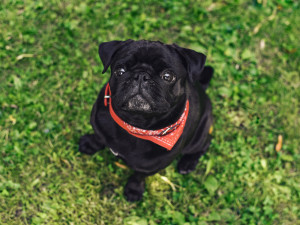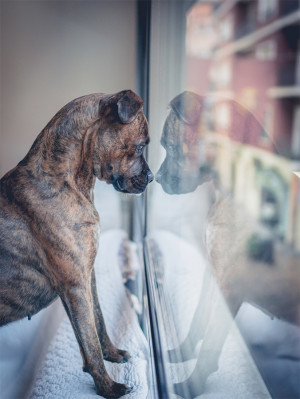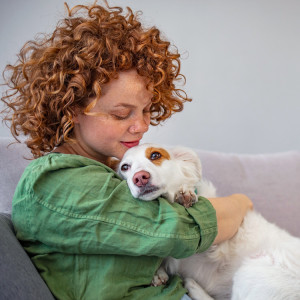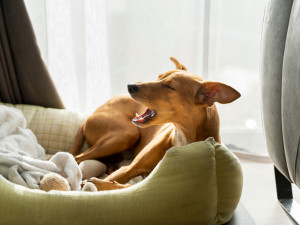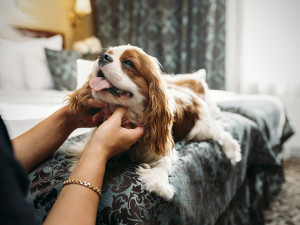Why Does My Dog Have Eye Boogers?
Next question: Will they let you anywhere near their eyes to wipe off that gunk?

Share Article
In This Article:
Common Causes of Eye Boogers in Dogs Why Does My Dog Have Excessive Eye Boogers? 7 Possible Health Issues Home Care for Dog Eye Discharge Frequently Asked Questions
Eye boogers, or ocular discharge, are common in dogs and can range from normal tear production to signs of underlying health issues. While some eye discharge is natural, excessive or abnormal discharge may indicate problems like allergies, infections, trauma, or more serious conditions.
Common causes of eye boogers in dogs
Tears are an important part of healthy eye function. Tears provide lubrication, protection, nutrients, and oxygen to the surface of the eye. The occasional eye booger is to be expected, but excessive eye boogers in dogs can be unsightly and sometimes bothersome. Ocular discharge usually occurs secondary to inflammation in or around the eyes. Inflammation can develop from trauma, infection, irritation, allergies, or immune-mediated disease.
Normal eye boogers tend to be clear or opaque in appearance. Color changes to ocular discharge often indicate a problem. If you notice yellow or green discharge in a dog, eye infection is a top concern. Red ocular discharge can occur with trauma or indicate worsening of an underlying eye issue.

Why does my dog have excessive eye boogers? 8 possible health issues
Conjunctivitis
Conjunctivitis, commonly called “pink eye,” refers to inflammation of the conjunctiva — the mucous membrane that lines the inside of the eyelid and the whites of the eyes. Signs of pink eye in dogs include redness, swelling, and excessive discharge.
Conjunctivitis is used as a broad diagnostic term, but there is usually an underlying cause. Common causes of conjunctivitis in dogs include allergies, infection, and trauma. It can also occur secondary to other health issues affecting the eyes. Treatment is dependent on the cause, but typically involves therapy to reduce inflammation and medications to combat infection (if present).
Bacterial or viral infections
Canine infectious respiratory disease complex (CIRDC), also known as “kennel cough,” is a highly contagious respiratory infection in dogs. CIRDC is spread through infected respiratory droplets, direct contact with an infected dog, and contaminated objects like toys and bedding. CIRDC is typically caused by a combination of viral and bacterial pathogens, which commonly include at least one of these pathogens:
Canine parainfluenza virus
Canine adenovirus type 2
Canine influenza virus
Canine respiratory coronavirus
Canine herpesvirus-1
Canine distemper virus
Bordetella bronchiseptica
Mycoplasma spp
Dogs are often infected days before they show any symptoms, allowing more time for the disease to spread before anyone notices. Symptoms of CIRDC include a dry, hacking cough, nasal discharge, eye discharge, sneezing, and lethargy. The illness is usually self-limiting, and many dogs recover with basic supportive care, but some cases can progress to pneumonia and cause fever and difficulty breathing.
Dry eye (KCS)
Keratoconjunctivitis sicca (KCS), or “dry eye,” is a common cause for thick, goopy eye boogers in dogs. Tears help to preserve eye health by maintaining moisture, protecting from bacteria, and washing away foreign material. KCS in dogs is typically immune-mediated, with the dog’s immune system attacking the lacrimal (tear) glands. When tear production is insufficient, the tears turn thick and mucoid instead of watery, and the eyes can become red and inflamed.
Allergies
Dogs can be allergic to proteins in their food or elements in their environment like dust, mold, or pollen. Itchy skin is the most common symptom of allergies in dogs. Dogs with allergies can also experience chronic ear infections and red, itchy, watery eyes.
Foreign bodies
Anyone who’s gotten a single eyelash in their eye knows the frustration, irritation, and waterfall of tears that follows. Dogs can get hair, plant material, or other debris caught in their eyes, causing excessive tear production. Flushing your dog’s eyes out with a dog-safe eye wash is safer than letting them constantly rub and paw at their eyes.
Corneal abrasions
So, your dog rubbed and pawed at their eyes when you weren’t looking and now they’ve scratched their cornea — the clear coating on the front of the eye. Corneal scratches or trauma can occur from foreign material in the eye, sharp objects scratching the eye, or self-inflicted injuries (constant pawing at the eye). Treatment typically involves medicated eye drops and a cone to prevent further scratching.
Corneal ulcers
A corneal ulcer is essentially an open wound on the cornea. Corneal ulcers in dogs are commonly caused by dry eye (KCS), injury, infection, or other eye diseases. Corneal ulcers can be sterile or infected, superficial or deep, simple (quick to heal) or indolent (slow to heal). Sometimes deep corneal ulcers that are not healing require surgical intervention.
Anatomical abnormalities
Anatomical differences in dogs can lead to eye discharge. These changes affect eyelid function or tear production and can cause chronic irritation. Anatomical changes that can cause eye boogers in dogs include:
Entropion: In dogs with entropion, the eyelid rolls inward, causing the eyelashes and facial fur to rub and irritate the cornea, leading to inflammation and excessive tearing. Entropion usually occurs in the lower eyelid of dogs and is usually corrected with surgery. Breeds that are predisposed to entropion include Labrador Retrievers, Chow Chows, Great Danes, English Bulldogs, and Bloodhounds.
Ectropion: Ectropion refers to the outward rolling of the eyelids, resulting in exposure and drying of the conjunctiva. This can lead to inflammation, increased tear production, and increased risk for eye infection. Ectropion is commonly diagnosed in Saint Bernards, Spaniels, Bloodhounds, Great Danes, and Newfoundlands.
Lagophthalmos: Blinking keeps eyes lubricated and helps clear away debris. Lagophthalmos refers to the inability to fully close the eyelids, leaving the cornea exposed to dry air and possible trauma. Lagophthalmos can be the result of shallow eye sockets, which are commonly seen in brachycephalic (short-nosed) breeds like French Bulldogs, Boston Terriers, and Pugs.
Home care for dog eye discharge
When addressing your dog’s eye discharge at home, the goal is to ensure comfort and promote healing while avoiding anything that may set back healing or make the eye worse. Be sure to follow your vet’s instructions if providing nursing care at home.
How to clean eye boogers
Cleaning the discharge from your dog’s eye can (sometimes) be soothing for your dog and may be part of your vet’s recommendations for at-home care. Clearing away the boogers also makes it easier for topical medications to actually reach the eyes. Here are some tips to clean your dog’s eye discharge:
Be gentle: Remember the first goal is to not make things worse.
Use soft supplies: Moisten cotton balls, cotton rounds, or a wash cloth with warm water. Saline eye wash solution works too, but may not be necessary.
Avoid abrasive material: Don’t use paper towels or anything stiff or with sharp corners; you risk accidentally scratching your dog’s cornea this way.
Gently wipe the discharge away: Use the cotton or cloth to gently wipe the discharge away. If the boogers are extra crusty and don’t want to budge, hold moistened cotton balls or cloth as a warm compress for a minute or so to help loosen it up before trying again to wipe it away.
Dog eye discharge home remedies
It’s normal for dogs to get eye boogers from time to time. They may have the occasional crust in the corners of their eyes or clear discharge. If their eyes look clear and healthy, there’s no history of trauma to the eyes, and they are doing well otherwise, you can try these therapies at home:
Gently clean away boogers using the instructions above.
Do not allow your dog to rub or paw at their eyes. If you see this, place an e-collar on them and contact your vet.
If your dog has something in their eye, you can rinse with a doggy saline eye wash solution to clear the irritant out. Do not use Visine or contact lens solution.
Keep a close eye on your dog’s eyes. If you go from “my dog had one eye booger this morning” to “my dog has a red, cloudy eye and discharge,” it’s time to seek veterinary care.
When to seek veterinary care
Any change to the eyes warrants at least a phone call to the vet. It’s always best to have your dog’s eyes checked out and make sure they’re on their way to healing rather than wait until the problem worsens and becomes a threat to your dog’s eyes or vision. Things that you should prompt you to seek veterinary care ASAP include:
Sudden blindness
Eye color change
Bleeding in the eye
Change in eye size
Bulging eye(s)
Painful eyes
Persistent abnormal pupil size (large or small)
FAQs:
What are the most common eye problems in dogs?
Common eye problems in dogs include dry eye (KCS), eye infections, trauma, cataracts, glaucoma, uveitis (inflammation inside the eye), cherry eye, and anatomical issues. Any changes to a dog’s eyes should receive prompt veterinary attention.
How do you treat a dog’s goopy eye?
The best way to treat a dog’s goopy eye is to have it evaluated by a veterinarian to determine the cause and best course of action. Treatment can range from a simple eye flush to a short course of eye drops to chronic medications.
What is canine distemper?
Canine distemper is a contagious infectious disease that can impact a dog’s respiratory, gastrointestinal, and nervous system; it can cause GI upset, goopy eyes, and seizures. Prognosis for dogs with distemper is guarded to poor, so vaccination is strongly recommended.
References:
“Canine Infectious Respiratory Disease Complex (Kennel Cough).” American Veterinary Medical Association, www.avma.org/resources-tools/pet-owners/petcare/canine-infectious-respiratory-disease-complex-kennel-cough.
“Disorders of the Cornea in Dogs - Dog Owners.” Veterinary Manual, www.msdvetmanual.com/dog-owners/eye-disorders-of-dogs/disorders-of-the-cornea-in-dogs.
Gelatt, Kirk N. “Disorders of the Eyelids in Dogs.” MSD Veterinary Manual, 18 June 2018, www.msdvetmanual.com/dog-owners/eye-disorders-of-dogs/disorders-of-the-eyelids-in-dogs?query=entropion. Accessed 20 Nov. 2024.
Ofri, Ron. “Diagnosis and Treatment of Dry Eye in Dogs.” Dvm360, vol. 54, 17 Mar. 2021, www.dvm360.com/view/diagnosis-and-treatment-of-dry-eye-in-dogs.

Dr. Alycia Washington, DVM, MS
Alycia Washington is a small-animal emergency veterinarian with over 10 years of experience based in North Carolina. She works as a relief veterinarianopens in new tab and provides services to numerous emergency and specialty hospitals. She also works as a veterinary writer with a focus on educating pet parents.
Related articles
![Dog Looking Out The Window.]()
Dog Vision: What Do Dogs See?
Those soulful eyes mean everything to you—learn all about them.
Can Dogs See in the Dark? Does My Dog Have Night Vision?
Hopefully, they at least fare better than we do when the lights go out.
![Woman with her dog relaxing in living room.]()
How to Tell If Your Dog Is Sick
Look out for these warnings signs so you know when to call the vet.
Can Dogs Get Colds?
We’re all sniffling this time of year. Learn if your pup can get a cold, too.
![Dog laying down in dog bed and coughing]()
Why Is My Dog Coughing?
Seven reasons to be concerned when your dog is coughing.
![Cavalier King Charles Spaniel's eye is examined on the bed by a person]()
Dogs Get Dry Eye Too...Some Breeds More Than Others
Eyes without tears are only for Cameron Diaz in The Holiday.


